#lady of the two lands ( hatshepsut )
Text

MWW Artwork of the Day (8/2/23)
Eighteenth Dynasty (Egyptian, c. 1550–1292 BCE)
Seated Statue of Hatshepsut (c. 1473–1458 BCE)
Indurated limestone statue, 195 x 49 x 114 cm.
The Metropolitan Museum of Art, New York (Rogers Fund)
Hatshepsut, the most successful of several female rulers of ancient Egypt. This life-size statue shows Hatshepsut in the ceremonial attire of an Egyptian pharaoh, traditionally a man's role. In spite of the masculine dress, the statue has a distinctly feminine air, unlike most other representations of Hatshepsut as ruler. Even the kingly titles on the sides of the throne are feminized to read "the Perfect Goddess, Lady of the Two Lands (Upper and Lower Egypt)" and "Bodily Daughter of Re (the sun god)."
3 notes
·
View notes
Text
Interesting historical manga I've found
Anna Comnena is a comedic four-panel manga by Futaba Sato about the titular princess and historian of the Byzantine Empire.
Aoi Horus no Hitomi is a gorgeous manga by Chie Inudoh about Hatshepsut's life and struggles as the female pharaoh in the 18th Dynasty of the New Kingdom. Licensed in French by Ki-oon, in Chinese by Tong Li Publishing, in Polish by Studio JG, in Korean by 영상출판미디어 (I can't find their official English name), and in Italian by Edizioni BD.
Blissful Land is a slice-of-life manga by Ichimon Izumi about a young doctor-in-training who finds himself engaged to a foreign girl in 18th-century Tibet. Licensed in English by Kodansha Comics, in Polish by Studio JG, in Spanish by Milky Way Ediciones, and in French by nobi nobi!.
Kuranishi has written two manga series set in Tibet: Ruten no Terma stars a Japanese man in search of his missing brother in modern Tibet while Tsuki to Kin no Shangri-La/Shangri-la for moon & diamond stars a young boy who is mysteriously left by his father at a Tibetan temple.
Tenmaku no Ja Dougal/A Witch's Life in Mongol by Tomato Soup is about an educated slave girl named Sitara who is taken prisoner of war by the Mongolian Empire when Prince Tolui's army sacks her first mistress Fatima's town in Islamic Iran. Taking the name of her first mistress, Sitara becomes a lady-in-waiting to Sorghaghtani, who happens to be Tolui's wife, and has a fateful encounter with Töregene, Ögedei's resentful wife from a defeated enemy tribe.

Vlad Drăculea by Akiyo Ohkubo depicts Vlad III's life as he goes from the puppet monarch of Wallachia to the feared defender of the land against the Ottoman Empire. This manga stands out for its subdued aesthetics and aversion of Big Anime Eyes. Licensed in French by Editions Soleil.
16 notes
·
View notes
Text
HATSHEPSUT & SENENMUT
HATSHEPSUT AND SENENMUT
Hatshepsut became regent to her young stepson after her husband died. As her stepson became a teenager he was more interested in riding in chariots, hanging out with people his own age, hunting and going into battle. He had no interest at the time for politics or to hang out with older people. Hatshepsut died in 1458 BCE, and then her stepson came to power.
Senenmut was a powerful figure during Hatshepsut’s rule. He was a commoner but was educated, intelligent and talented, Hatshepsut relied on him for building projects and he also became her daughters tutor; there are monuments depicting Senenmut and the princess together. Due to his intellect and talents he grew high in the royal court. Senenmut was the architect of Deir el-Bahri and also put an image of himself and his name on the walls, which is unusual for a commoner. He also was documented as saying, “I entered the mysteries of the lady of the two lands”.
Hatshepsut never remarried, and Senenmut never got married or have children, which was unusual for a man in Ancient Egypt. If the two were lovers they would have had to keep it a secret, as it wouldn’t have been permitted for royalty to be with a commoner. During her rule, one of Senenmut’s workers who was working in the DjeserDjeseru tomb, graffitied on the wall and drew an image of Senenmut having sex with a female pharaoh (Hatshepsut).
Senenmut had two tombs built, one for Hatshepsut and one for himself, they were built in the same proximity to each other. When Senenmut died, she gave her own sarcophagus for him to be buried in, no commoner has ever had the privilege to be buried in a royal sarcophagus before. Hatshepsut died a few years after.
Their tombs were vandalized when Hatshepsut’s stepson and his own son reigned, as they wanted Hatshepsut’s memory to be erased.
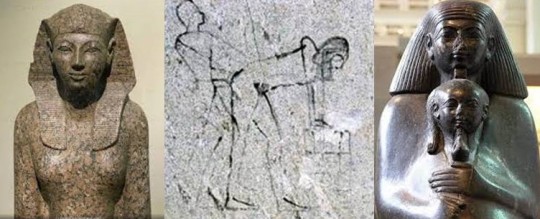
#hatshepsut #senenmut #ancientegypt
1 note
·
View note
Photo
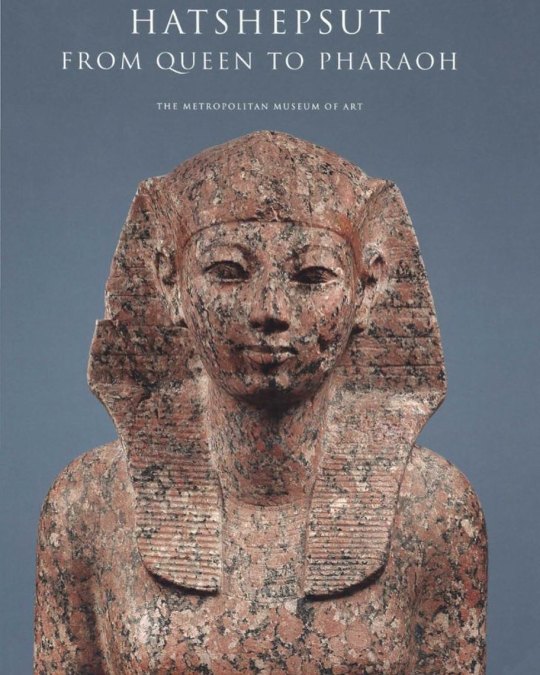
Hatshepsut (Hatchepsut; "Foremost of Noble Ladies"; c. 1507– January 16, 1458, BC) was the fifth pharaoh of the Eighteenth Dynasty of Egypt. She was the second historically confirmed female pharaoh, after Sobekneferu. (Various other women may have also ruled as pharaohs regnant or at least regents before Hatshepsut, as early as Neithhotep around 1,600 years prior.) She came to the throne of Egypt in 1478 BC. As the principal wife of Thutmose II, she ruled as regent to Thutmose III, a son of Thutmose II by another wife and the first male heir. While Thutmose III inherited the throne at about two years old, she continued to rule by asserting her lineage as the daughter and only child of Thutmose I and his primary wife, Ahmose. Her husband Thutmose II was the son of Thutmose I and a secondary wife named Mutnofret, who carried the title 'King's daughter' and was probably a child of Ahmose I. She and Thutmose II had a daughter named Neferure. Thutmose II with Iset, a secondary wife, would father Thutmose III, who would succeed her as pharaoh. She re-established the trade networks that had been disrupted during the Hyksos occupation of Egypt during the Second Intermediate Period, thereby building the wealth of the Eighteenth Dynasty. She oversaw the preparations and funding for a mission to the Land of Punt. This trading expedition to Punt was during the ninth year of her reign. It set out in her name with five ships, accommodating 210 men that included sailors and 30 rowers. Many trade goods were bought in Punt, notably frankincense and myrrh. She was the first female Pharaoh of Tawi, the ancient two lands, more commonly referred to as Egypt. Not only did she lead a dangerous expedition to Punt, the mysterious homeland of the ancient Egyptians in the Horn of Africa, something no male Pharaoh had done in almost 800 years, but she built one of the nine wonders of Egypt, her mortuary temple which still stands today! #africanhistory365 #africanexcellence https://www.instagram.com/p/Cned-oALxOf/?igshid=NGJjMDIxMWI=
0 notes
Text

Most of Layla’s perspective of Gallifrey and Gallifreyans in general is heavily coloured by the few Gallifreyans adopted into the Osirian Court, as well as the Court’s dealings with the Faction Paradox.
Her ‘Uncle Thoth’, more formally known as Mortegathoth vel-Dvora, was the Great Houses’ ambassador to the Osirian Court during the War in Heaven. The Egyptians revered him as the “ape-headed” god of time, among other things.
Her father, Anubis, had several personal dealings with the Faction Paradox, as it was from them that he obtained his remembrance tank - a form of loom with which someone could come and literally “remember” the person into existence with the appropriate quantity of biomass that would be placed in the remembrance tank and a headset would be attached to the tank.
The only other Time Lord that she really knew anything about besides those who became part of the Court is the Doctor, who was repeatedly responsible for the defeat of her grandfather, Sutekh, and who also served as an advisor to her human mother, Pharaoh Hatshepsut.
While her mother’s stories of the Doctor - and later her father’s, as the Doctor was in part responsible for his rejuvenation, which later allowed for Layla’s birth in the first place - helped temper her terror of the Oncoming Storm who has fought and triumphed over the Destroyer, she is often still extremely wary of the Doctor, especially at their first proper meetings as an adult when she herself has become known as a Chaos Bringer.
This is true, at least on a deep subconscious level, even if she manages to form a trust and friendship for the Doctor. Her ability to see into the parallels of what could be and could have been plays a large part in that remaining true in nearly all of her personal timelines.
#reality is frequently inaccurate ( headcanons )#jackal's child ( layla jacquel )#moving like i own this time ( osirian hybrid )#the paradox of our time in history ( osirian court )#the god of time ( mortegathoth )#the destroyer ( sutekh )#lady of the two lands ( hatshepsut )#no respect for the status quo ( to be tagged )
1 note
·
View note
Photo

This graceful, life-size statue depicts Hatshepsut in female attire, but she wears the nemes–headcloth, a royal attribute usually reserved for the reigning king. In the columns of text inscribed beside her legs on the front of the throne, she has already adopted the throne name Maatkare, but her titles and epithets are still feminine. Thus, she is "Lady of the Two Lands" and "Bodily Daughter of Re."
The pose of the statue, seated with hands flat on the knees, indicates that it was intended to receive offerings and it was probably placed in one of the Temple's chapels. In more public areas, such as the processional way into the temple, colossal sphinxes, kneeling and standing statues represent Hatshepsut as the ideal king, a young man in the prime of life. This does not mean that she was trying to fool anyone into thinking that she was a man. She was merely following traditions established more than 1500 years earlier. [X]
163 notes
·
View notes
Text
Akhenaten
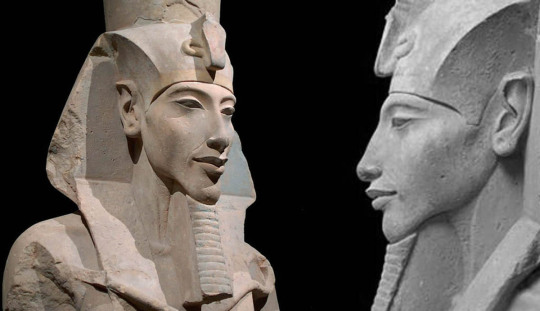
The name Akhenaten is rather well known as a Pharaoh of Egypt. Like Ramesses II, Hatshepsut, Cleopatra, and Tutankhamun, Akhenaten won the popularity contest of modern society through defining himself as far different from most other Pharaohs. With Akhenaten, however, he’s not even like the special Pharaohs.
Let’s look a little at his life and the history of the time period he ruled over. He was in the 18th Dynasty of the New Kingdom, from 1353-1336 BC. Like most Pharaohs there are a few different pronunciations of his name, including Akhenaton, Ikhnaton, Khuenaten, all meaning of great use to Aten, which leads into his conversion into the cult of Aten. Before the conversion his name was Amenhotep IV, son of Amenhotep III. His mother was named Tiye. Later on in life he married Queen Nefertiti, fathering two children, one from his wife Nefertiti and one from his lesser wife, Lady Kiya, having Ahnksenamun and Tutankhamun to each wife respectively.
Before we get into the whole mess of his religion and the ‘revamping’ he did of ancient Egypt, let’s recognize the other things he did for or to the country.
You’ll recognize the vastly different art style between Akhenaten’s rule and the history of most of Egypt. In art that depicts Akhenaten, he was shown as long and spindly, a style that carried into his family. Some people believe that this was because he and his family suffered from Marfan’s syndrome, a disease that caused the elongation of bones and skinniness. A more likely explanation stems from the Pharaoh’s religious beliefs, which as you know, was vastly different from other Pharaohs. This theory is a little more likely because there was no reason for the queen Nefertiti to have the same condition as her husband. Instead, it was probably because their status was far different from the other Pharaohs, as they were moved into a genuinely god-like status for their worship of Aten.
The part of Akhenaten and his rule that interests me the most is the way the royal family was presented in art, despite the style. Like many parts of Akhenaten, it’s entirely different from other Pharaohs (though, whether that’s good or bad is up to you).
Now, most Pharaohs presented themselves highly in art. They could do that, so why not? If I had the guts and the money I probably would too, but my point is that essentially all Pharaohs depicted themselves alone on stelas, engaging in hunting or other activities that strengthened the image of themselves that they wanted to show the world. Usually they were masculine tasks that could be done only by those with great strength and great riches. Akhenaten went in an entirely different direction; he depicted himself with his family. In the stele of Akhenaten, he is shown in a private way, the scene being him with his family, enjoying themselves together.
While we can’t say the definitive reason for him presenting himself as this, the most logical conclusion has to do with, again, his religious beliefs. In his mind, the Aten was held above all else, even the Pharaoh. With Aten as the highest consideration, the Pharaoh and his family enjoyed their lives under the influence of the Aten’s love and grace.

Now that we have a little insight, let’s get into the whole mess of his religion that died immediately after he did.
Akhenaten originally reigned as Amenhotep IV, a reign that lasted around five years before he switched religions. Changing his name, he converted to a cult that worshipped Amun to that of Aten, abolishing the ancient rites of those before him, and instituting what is believed as the first example of monotheism state religion in the world. His rule as Akhenaten lasted 12 years, during which he was labelled as the infamous ‘heretic king’, so that should give you some insight into how people felt about him.
Before his rule, the cult of aten was a cult like all others in Egypt. It was a bit like choosing your favorite God – find the one you like most, and join that cult. For example if I were to join a cult, I would join the cult of my favorite God, Ma’at. I mention this because before the change, the Aten was shown in inscriptions of Akhenaten (Amenhotep IV at that point), represented by the sun disk. It’s also important to note cult doesn’t carry the same meaning as it did then, and each cult shared the same goal: balance and eternal harmony.
At the time of Amenhotep IV’s rule the Amun cult (where the Aten is from) held incredible power. Their power had been growing for a long while, and by the time of his rule, they held nearly as much power and riches as the Pharaoh himself, and actually owned more land than Amenhotep IV. The fifth year of his reign he switched everything; this was when he abolished the practices of the previous religion of Egypt, and proclaimed himself the “living incarnation of a single all-powerful deity known as Aten,” (Joshua J Mark), and by the ninth year, he closed every single temple, prohibiting all the old practices and devotion to the many Gods the people of Egypt worshipped.
Around then was when he moved the royal seat of Egypt from the traditional house of Thebes to a city of his own creation, a city named Akhetaten, and with that he changed his name to Akhenaten. Here he earned the name the Heretic King, earning the ire of some historians and the admiration of others.
Despite the fact that Akhenaten’s influence completely destroyed worship of the Gods many Egyptians loved, one of the main problems with his rule was that the Old Gods of Egypt instilled harmony and order in the citizens, ultimately helping to create a country that lasted over 4,000 years. Without these Gods, things got a little wonky.
Religious tolerance was allowed with the many Gods, emphasizing peace to the point where religious intolerance wasn’t even an issue. Unfortunately, for monotheism to work, there has to be something inherently wrong with the other side, which made Akhenaten’s work a lot harder, and its’ effects much stronger. It led to the intolerance of other beliefs and some severe suppression, and if you look at the monotheistic religions of today, you can see the same sort of pattern. With intolerance comes hatred and war.
“Dating to this point in Akhenaten’s reign was a campaign to excise the name of gods other than the Aten, especially Amun, from the monuments of Egypt. This was done with violence: hieroglyphs were brutally hacked from the walls of temples and tombs. This was probably carried out, at least in part, by illiterate iconoclasts, presumably following the orders of their king. [Akhenaten] carried out a religious revolution the like of which had never been seen before in Egypt.” (Zahi Hawass, 42-43).
There were priests of Atum who attempted to hide religious artifacts, storing statuary and texts away from the soldiers ordered to destroy them. The priests, with nothing left to do, were forced to abandon their temples. In response Akhenaten either hired new priests or forced the other ones to obey him, proclaiming him and his wife once more as Gods on earth.
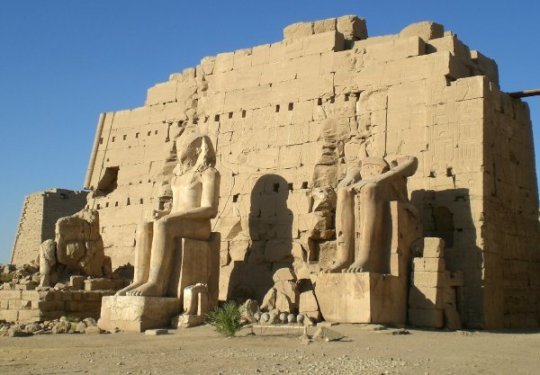
Now you can see how Akhenaten kind of sucks. Let’s talk about how he sucks even more.
His foreign policy.
With his ego inflated to the size of the sun, Akhenaten thought himself above interactions with foreign powers. He left his duties to spend more time on himself and his family, ultimately leading to a severe neglect.
You might be asking, “didn’t every Pharaoh have a super-inflated ego?” and yes, you’d be right, but no Pharaoh before Akhenaten had genuinely claimed themselves to be a God. As a self-proclaimed incarnated God, he must’ve thought such affairs beneath him.
Discovered through letters of the time, several (former) allies of Egypt had asked for their help several times with various affairs. At the time Egypt was wealthy, prosperous, and strong, a state that had been slowly growing before halting at Queen Hatshepsut’s reign. Hatshepsut and her successors employed a strategy of actually doing work, by working out when to approach with diplomacy, and when military action was required. Akhenaten on the other hand, ignored everything outside of his palace at Akhetaten.
The uncertainty of Akhenaten’s rule, along with letters of correspondence between the city of Amarna, the Pharaoh, and foreign nations, led to this era being called the Amarna period. These very letters were proof of the Pharaoh’s negligence. However, the letters also show his keen eye in foreign diplomacy, if the situation interested him so. It was a whole thing with the Hittites, but since this is chiefly about Akhenaten, I’ll leave that topic for later. All you really need to know is that he only tended to issues that affected him directly, and through the Amarna letters, historians can see how poor of a King he was, as well as how deeply many of his subjects disliked or despised him.
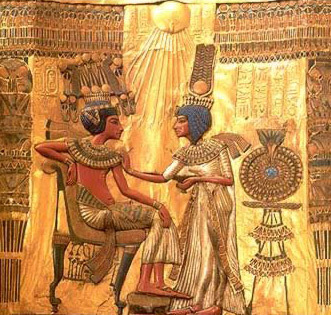
Essentially, the main reason this mess didn’t work out was because it brought about something new: exclusivity. And the Egyptians did not like that, believing that the world needed to have a balance in order to stay away from slipping into chaos. In the end monotheism didn’t last; hell, it was ended basically the second Akhenaten’s son took the throne. Tutankhamun, originally named Tutankhaten, changed his name to reflect the return to polytheism. His successors tore down the reminders of Akhenaten’s reign, removing him and his adoration for the Aten, eradicating his name from the record.
There’s no saying he didn’t affect the world – he did, a lot. Whether that affect was good or bad is up to the interpreter (personally I don’t like it all that much). By Freud’s thinking (hear me out, I know he sucks) Akhenaten’s rule inspired the ancient world, leading others to copy his ideas and theology, eventually snowballing into our modern world, where there are essentially no polytheistic religions. You have to give him credit – he was the first person of the ancient world to dream up monotheism, changing what had defined humanity for so long.
With his name stricken from the books, historians only discovered him upon finding his city Akhetaten. In the records, Horemheb is labelled as Amenhotep III’s successor, skipping over both Akhenaten and Tutankhamun’s rule. Later when Tutankhamun’s tomb was found as one of the very few graves still filled with treasure, interest spiked in Tutankhamun’s life, eventually leading back to his father Akhenaten.
88 notes
·
View notes
Text
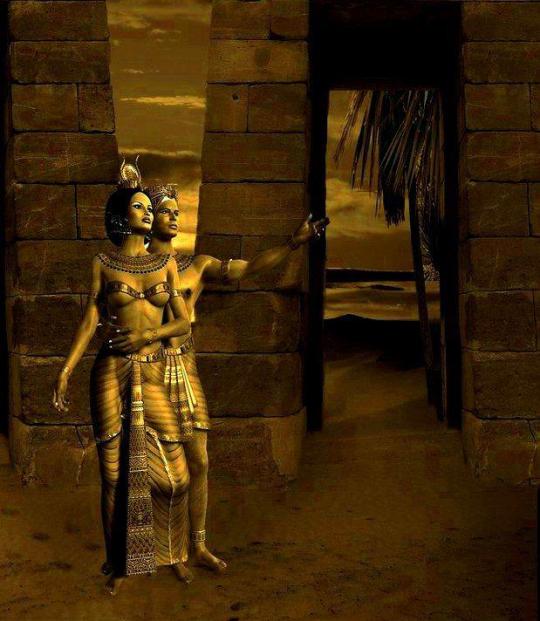
The love story of the Queen (Hatshepsut) and the engineer (Senemut
The love story of the Queen (Hatshepsut) and the engineer (Senemut):
Hatshepsut was truly the man's woman. Her life did not know femininity, she represented herself in the clothes of the pharaoh, and we see her on her obelisk in the form of a young man wearing the puffy blue crown from which the royal uraei overlooks the forehead, and above her chest, the king with seven circles or six rows and in her waist an apron covering her legs even above the knee as she kneels between The hands of Amun-Ra.

In another picture, she appears with her false beard, as is the custom of the pharaohs, which is in all her pictures flat-chested, and the feminine t-shirt was raised from her name, for she is the king of Egypt, not her queen, and she is Hatshepsut and not Hatshepsut.

Hatshepsut was the rope in which Lower Egypt rests and the pillar upon which Upper Egypt depends, and she was the straight rudder of the Delta and the lady who administered plans and issued orders.
The queen was able to monopolize power, relying on the strength of a strong party in the royal court consisting of Senmut the minister and the great architect, and this (Senmot) was very smart and very active, then (Hapo Senet) the high priest, then (NHC) the bearer of seals, then the Minister of the Treasury.
And the most beautiful in the whole story is the warm love story that many historians wrote about between Hatshepsut and the engineer "We shall die."
He loved (Senmut) his queen dearly, and he expressed this love for building her famous temple in Deir el-Bahari, which is one of the most beautiful places that we can visit in the world. He was given 80 titles and was responsible for caring for her only daughter. His love for his queen reached the point that he dug a tunnel between her cemetery and his grave and a corridor, so he chose "We Will Die" the most appropriate place to build this temple of love, as if he wanted to tell his lover that their love will remain eternal.
The queen and her servant had participated in a "legendary life," and each ended a mysterious end that remains a mystery until now.
(We shall die) and his dominion over the throne:
Senmut was the most important figure in the court of Hatshepsut, and he saw with insightful eyes that Hatshepsut's marriage to her brother Tuthmosis the Second was a sham marriage to show before the Egyptian people that on the couch of the throne is Pharaoh, but the reality is that Hatshepsut was in control of the country because she is the true heir to the throne.
And he was looking forward to forming a party that would include among its members all sincere statesmen who had shown skill and dexterity of her generation to seek help from them in the fulfillment of her interests.
The first person to choose Hatshepsut was Ali (Senmut), the director of Beit Amun, and he was an energetic young man who drew his gaze, capable of ambition, and saw with his eyes that the opportunity was ripe for him to have eternal glory.
As for Hatshepsut, and since her eyesight fell on him, her soul was united with his spirit, and her future was fully linked to the matter of his guardianship over her two daughters, and from the moment she established the pillars of the guardianship on the throne, Saad Sanmut's political star seemed to appear on the horizon and shine. Hatshepsut's first step was to make Senmut the first educator of her royal daughter, the princess of the two lands and the royal wife Neferora) and the director of the great house of her and her daughter's properties, and he was an effective partner in ruling the country.
During the reign of Hatshepsut, he became under his administration all the wealth of the house, the owner and director of the great house of the two queens Hatshepsut and Nefro-Ra and the superintendent and supervisor of all the supervisors of all the works of Pharaoh. The control of the Pharaoh’s servants, finances, weapons, and the Red Crown Palace was in addition to all these high-ranking jobs, which were not occupied by those who were not very close, such as preparing royal toiletries for official visits, observing private rooms, the bathroom and the bedroom as well.
We will die and his marital status:🤔💜🌺🌹
Senmut was descended from a modest family, his parents were not of those with standing in social life, for his father, who was called Ramosi, was a thin peasant or a simple soldier whose stature was short, thin and old, but he was Zaki, and his mother, Mrs. Hat Nofer, nicknamed Theo Theo, was an old, fat, short housewife. Three brothers, none of whom held a position in the state except for his brother Sen, who sought help from him as his assistant in managing princesses' affairs.
Senmut married two wives, one of whom was called Tafret Hor, and the second, Aaa Hotep, and he had no children.
Senemut is considered a unique case in the history of ancient Egypt, as his name is in the best distinctive places in the temples. He and Hatshepsut is depicted in front of the god. He was called the priest of the sacred ship of the god Amun and the chief priest of the Temple of Montu in Armant, and he was a first-class administrator. He started his life in managing the vast loss of Amun in the temple Karnak, who was the superintendent of the crops, stores, fields, gardens, livestock and slaves, and the superintendent of the hall of Amun as the director of the great house and director of all the king's works.
Unique (Senmut) tombs:
And there is a unique phenomenon, so we will die possessing two graves, the first in the hills of Sheikh Abd al-Qurna, and the second unveiled in Deir al-Bahari. Deir al-Bahari indicates a close connection between the queen and her engineer and a certain desire to unify their funeral rituals, so the layout of the cemetery and the royal cemetery is one, and the shape of the two coffins is one and the name of Hatshepsut is inscribed on all the walls of the cemetery, and the religious texts inscribed in it appear only in the royal tombs and this is what confirmed the existence A strong love affair connects them.
But their mysterious end together makes their story set to be one of the most beautiful lovers' stories in human history.
He was isolated before his death and was not buried in his cemetery, and his name was smashed from its walls with a hammer and Hatshepsut died after a 20-year rule, and it was believed in the past that she was killed because of the dispute over the ruling and her sudden disappearance, but now the mummy of Hatshepsut has been verified and it clearly shows signs of natural death, and that The cause of her death was due to her cancer or diabetes. Her tomb is located in the Valley of the Kings and is symbolized by the number KV20. Perhaps Hatshepsut expanded her father’s tomb to use it, and found her coffin next to her father’s.
But the question arises: Is love behind the disappearance ... After twenty years of life as a man, you may have decided to leave the throne for the sake of her lover (we will die) and run away with him and disappear forever and as a love story that you never knew ... ??
1 note
·
View note
Photo

This is a life-size statue, Hatshepsut (𓇋𓏠𓈖𓎸𓏏𓄂𓏏𓀼𓏪) “imn-ẖnmt ḥA.t-šps.wt” ‘United with Amun, Foremost of Nobel Ladies’ is shown wearing the nemes-headcloth 𓌰𓅓𓋴𓌆 “nms” and the shendwt-kilt 𓈙𓈖𓆓𓅱𓏏𓋯 “šnḏw.t”. These are part of the ceremonial attire of the Egyptian 𓂋𓐝𓎀𓀂𓀭𓏪 “rmṯ” king 𓇓𓈖𓏏 “nsw.t”, which was traditionally a man's role. In spite of the masculine dress, the statue 𓂙𓏏𓏭𓀾 “hnty” has a distinctly feminine air, unlike most representations of Hatshepsut as ruler 𓋾𓏘𓄿𓀭 “ḥq3” (for example, two over life-size statues that represent her kneeling, 30.3.1, and standing, 28.3.18). The kingly titles on the sides of the throne 𓊨𓏏 “st” are feminized to read "the Perfect Goddess , Lady of the Two Lands," and "Bodily Daughter of Re." Traces of blue 𓇋𓁹𓅂𓈒𓏫 “irtyw” pigment are visible in some of the hieroglyphs 𓌃𓂧𓅱𓀁𓊹 “mdw-nṯr” (divine writing) on the front of the statue and a small fragment on the back of the head 𓁶 “ḥr” (see attached photograph) shows that the pleats of the nemes-headcloth were originally painted with alternating blue and yellow 𓏘𓈖𓇋𓏏𓏬 “qni.wt” pigments. Statues that depict Hatashepsut in a more feminine form, like this one, are in a seated pose, with hands flat on the knees. This suggests that they were intended to receive offerings 𓏛𓏏𓊪 “ḥtp” and would probably have been placed in less public areas of the temple 𓉞𓉐 “hw.t” such as the chapels on the upper terrace. Two of these statues depicts her unequivocally as a woman. Source: https://www.metmuseum.org/art/collection/search/544450 Details: Seated Statue of Hatshepsut Period: New Kingdom Dynasty: Dynasty 18 Reign: Joint reign of Hatshepsut and Thutmose III Date: ca. 1479–1458 B.C. Medium: Indurated Limestone On view at The Met Fifth Avenue in Gallery 115. #egypt #egyptian #ancient #ancientegypt #hieroglyphics #ägypten #thisisegypt #egyptologist #myegypt #egyptianhistory #egyptology #archeology #hieroglyphs #madeinegypt #egypte #egyptians #egyptshots #loveegypt #discoveregypt #egitto #埃及 #مصر #egipto #hatshepsut #egyptianstatue https://www.instagram.com/p/CDKKg25niFx/?igshid=1xvcoej5oss3s
#egypt#egyptian#ancient#ancientegypt#hieroglyphics#ägypten#thisisegypt#egyptologist#myegypt#egyptianhistory#egyptology#archeology#hieroglyphs#madeinegypt#egypte#egyptians#egyptshots#loveegypt#discoveregypt#egitto#埃及#مصر#egipto#hatshepsut#egyptianstatue
3 notes
·
View notes
Photo
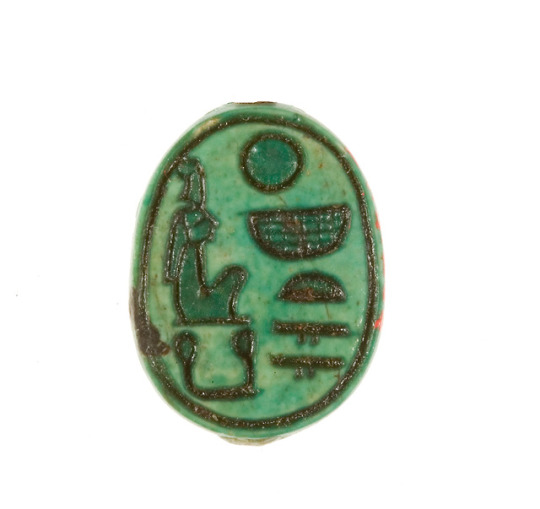
Scarab Inscribed Lady of the Two Lands Maatkare (Hatshepsut), Egyptian Art
Medium: Steatite (glazed)
Rogers Fund, 1927 Metropolitan Museum of Art, New York, NY
http://www.metmuseum.org/art/collection/search/549734
16 notes
·
View notes
Photo
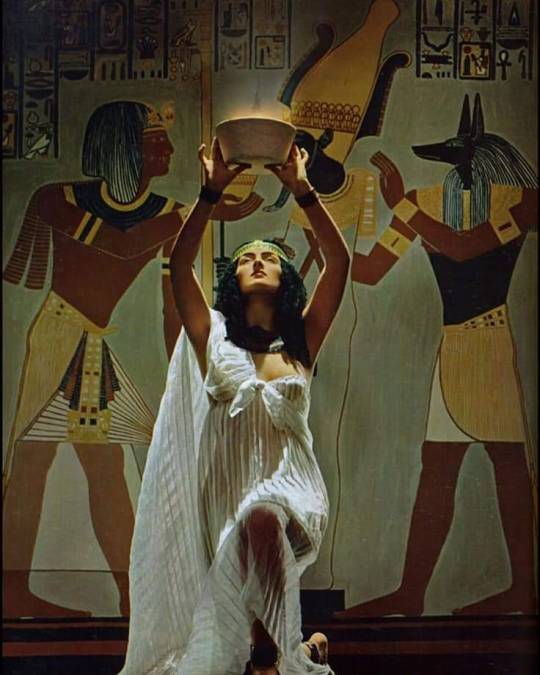
Nefertari, conosciuta anche come Nefertari Merymut, era una delle Grandi Mogli Reali (o mogli principali) di Ramesse il Grande. Nefertari significa "Beautiful Companion" e Meritmut significa "Beloved of [the Goddess] Mut". È una delle regine egiziane più conosciute, accanto a Cleopatra, Nefertiti e Hatshepsut. La sua tomba riccamente decorata, QV66, è la più grande e spettacolare della Valle delle Regine. Ramesse le costruì anche un tempio ad Abu Simbel accanto al suo colossale monumento. Nefertari deteneva molti titoli diversi, tra cui: Great of Praises, Sweet of Love, Lady of Grace, Great King's Wife, Lady of The Two Lands, Lady of All Lands, Wife of the Strong Bull, God's Wife, Mistress of Upper and Lower Egypt. . Ramesse II l'ha anche chiamata "The One for Whom the Sun Shines". "..... https://www.instagram.com/p/CFuNK0qIyxx/?igshid=x8paby7isxrb
0 notes
Photo

Seated Statue of Hatshepsut (ca. 1479–1458 B.C.) Hatshepsut (𓇋𓏠𓈖𓎸𓏏𓄂𓏏𓀼𓏪) “imn-ẖnmt ḥA.t-šps.wt” ‘United with Amun, Foremost of Nobel Ladies’, the most successful of several female rulers of ancient Egypt - Beloved Land - Tameri 𓇾𓌸𓂋𓆵𓇋𓊖𓊖 “tA-meri”, declared herself king sometime between years 2 and 7 of the reign of her stepson and nephew, Thutmose III (𓅝𓄟𓊃𓄤𓆣𓏫) “djhwty-ms-hprw” ‘Beautiful are the Reincarnations of Thumoses’. She adopted the full titulary of a pharaoh 𓉐𓉼 “pr-eA” ‘Great House’, including the throne 𓊨𓏏 “st” name Maatkare (𓇳𓁧𓂓) ‘Truthful is the Soul of Ra’, which is the name most frequently found on her monuments. Her throne name and her personal name, Hatshepsut, are both written inside oval cartouches making them easy to recognize. In this life-size statue, Hatshepsut is shown wearing the nemes-headcloth and the shendyt-kilt. These are part of the ceremonial attire of the Egyptian 𓂋𓐝𓎀𓀂𓀭𓏪 “rmT” king 𓇓𓏏 “sw”, which was traditionally a man's role. In spite of the masculine dress, the statue has a distinctly feminine air, unlike most representations of Hatshepsut as ruler (see, for example, three over life-size statues that represent her seated (27.3.163), kneeling (30.3.1), and standing (28.3.18)). The kingly titles on the sides of the throne are feminized to read "the Perfect Goddess, Lady of the Two Lands" and "Bodily Daughter of Re," a practice that was dropped later in her reign. Traces of blue 𓇋𓁹𓅂𓈒𓏫 “irtyw” pigment are visible in some of the hieroglyphics 𓌃𓂧𓅱𓀁𓊹 “mdw-ntr” (divine writing) on the front 𓄂𓏏 “hA.t” of the statue and a small fragment on the back of the head (see attached photograph) shows that the pleats of the nemes-headcloth were originally painted with alternating blue and yellow pigments. #egypt #egyptian #ancient #ancientegypt #hieroglyphics #ägypten #middleeast #worldtourismday #thisisegypt #egyptologist #myegypt #egyptianhistory #egyptology #archeology #hieroglyphs #madeinegypt #egypte #egyptians #egyptshots #loveegypt #discoveregypt #statue #queen #pharaoh #hatshepsut #nemes https://www.instagram.com/p/BwdD0q-lVEF/?utm_source=ig_tumblr_share&igshid=1c5hvwy207eml
#egypt#egyptian#ancient#ancientegypt#hieroglyphics#ägypten#middleeast#worldtourismday#thisisegypt#egyptologist#myegypt#egyptianhistory#egyptology#archeology#hieroglyphs#madeinegypt#egypte#egyptians#egyptshots#loveegypt#discoveregypt#statue#queen#pharaoh#hatshepsut#nemes
0 notes